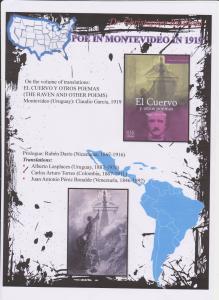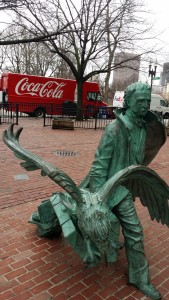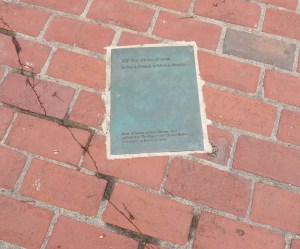I recently had the pleasure and privilege of attending the Edgar Allan Poe component of the annual conference of the American Comparative Literature Association (ACLA) held from 17 to 20 March 2016 within the august precincts of Harvard University.
The location was particularly appropriate as Poe was born in 1809 in Boston, just across the Charles River from Harvard’s city of Cambridge (and for his recently erected statue in his city of birth, see my post, also on this blog, from 27 March 2016). The Poe element of the conference consisted of two workshops or streams, ‘Global Poe’ and ‘Global Poe II’, which both took place in the charming late-nineteenth century setting of Harvard’s Sever Hall. That Poe’s global dimension should have been chosen as key theme for the workshops reflects the recent publication (2014) of the collective volume ‘Translated Poe’ (again see this blog, 29 October 2014), one of whose co-editors, Professor Emron Esplin of Brigham Young University, Utah, was the organiser of the conference streams, and to which I myself contributed a chapter on Poe translated in Mexico.
The two streams brought together a total of 16 scholars of multiple provenances. The diversity of facets of Poe’s life and work discussed, united by the common thread of the comparative dimension (international or transdisciplinary), was remarkable.
The transnational element in Poe begins with his childhood time in Great Britain, and this aspect was illuminated by Hal Poe (himself a relative), in a paper focusing on Poe’s experiences there, and especially in London. Next in line is logically France, the country of his work’s earliest substantial adoption thanks to the advocacy of Charles Baudelaire and Stéphane Mallarmé, and Susan Elizabeth Sweeney focused on Poe’s French connection with a paper on his ‘imaginary Paris’. In the Spanish-speaking world, the two great Argentinians Jorge Luis Borges and Julio Cortázar have played a signal role in diffusing Poe’s work, and Emron Esplin’s contribution offered fresh insights on Poe’s reception in Argentina. Brazil, too, has been fertile ground for Poe’s influence, and Fabiana Vilaço illuminatingly analysed his detective fiction from a Brazilian critical perspective. Another literature marked by Poe’s imprint is that of Russia, and Nikita Allgire’s paper thus compared works by the American author and Nikolai Gogol. Further afield, the Japanese connection was represented in two papers, via Kazuo Ishuguro and other writers in the similarities expounded by Yuji Kato, and via Edogawa Rampo, the Japanese writer who took his name from Poe, in J. Scott Miller’s discussion. A comparative dimension was also suggested between Poe and literature in Arabic by Hicham Mahdjoub Araibi, who pointed up the similarities between Poe and the Lebanese writer Khalil Gibran, author of ‘The Prophet’.
Other speakers placed Poe in relation to authors from more than one culture. Abigail Ray Alexander brought together a number of different strands relating to the murder theme, linking Poe variously to Samuel Taylor Coleridge, Jules Verne, and Turkey’s Orhan Pamuk, while Sonya Isaak connected Poe’s practice of ‘marginalia’ to similar endeavours by Coleridge and Baudelaire.
The comparative dimension also fanned out to include cross-disciplinary connections. Jenny Webb examined Poe’s work from the viewpoint of theology; and several speakers linked Poe to aspects of diverse sciences or pseudo-sciences. Karen Weiser compared the nineteenth-century British poet and botanist Erasmus Darwin; Pedro Madeira investigated Poe’s use of the mesmeric theories of his day; Slawomir Studniarz analysed Poe’s metrics from the viewpoint of phonosemantic theory; and Stephen Rachman proposed a link with the modern-day practice of ASMR (Autonomous Sensory Meridian Response).
My own paper (Christopher Rollason: ‘Edgar Allan Poe in Montevideo in 1919’), focused on ‘El cuervo y otros poemas’ (‘The Raven and Other Poems’), a volume of renderings of poems by Poe into Spanish by various Latin American translators, with a prologue signed by the major Nicaraguan poet Rubén Darío and published in Uruguay in 1919. The paper examines the backgrounds of the contributors to the volume and analyses prologue and translations from a pan-American viewpoint (with particular attention to the version of ‘The Raven’ by Venezuela’s Juan Antonio Pérez Bonalde). It is available on-line at: http://yatrarollason.info/files/PoeinMontevideo1919.pdf.
Plurality was the watchword of the two workshops, and was evidenced in the range of the papers themselves and the multiplicity of fellow scholars’ responses in the lively debates that ensued from them. Though Poe remains best-known for his tales of terror and detection, the diversity of genres he wrote in is remarkable. His status as iconic American writer can obscure the fact that his work has also benefited over time from an extraordinary global projection. There are many Edgar Allan Poes, and not all of them are American. Like his own raven perched on the bust of Pallas, Poe will never leave us, and it is to be hoped that this highly stimulating ACLA event will bear fruit in new and exciting transfrontier collaboration projects among ever better-informed Poe scholars.




















